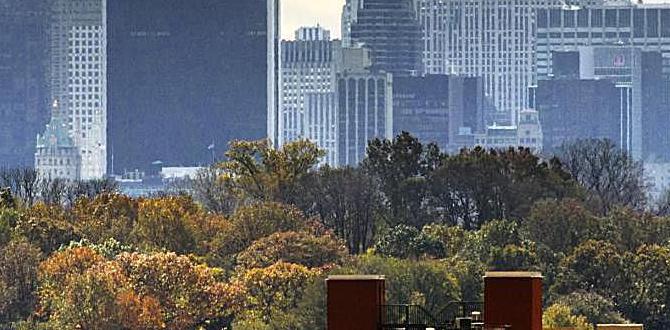Barcelona food neighborhoods explained: A beginner’s guide to discovering the city’s culinary hotspots. Explore the best areas for tapas, seafood, traditional dishes, and local markets to savor authentic Catalan flavors and make your foodie adventure stress-free.
Dreaming of Barcelona, a city alive with vibrant streets and incredible food? Navigating its culinary landscape can feel a bit overwhelming, especially when you’re eager to find the most delicious and authentic experiences. You want to taste the real Barcelona, from its famous tapas to fresh market finds, without wasting precious time or money. It’s completely understandable to want a clear path to the best flavors! This guide is designed to make it simple, breaking down Barcelona’s most exciting food neighborhoods so you can eat your way through the city with confidence and joy.
Discovering Barcelona’s Culinary Tapestry: An Essential Guide
Barcelona is a food lover’s paradise, a city where every corner seems to offer a new taste sensation. From bustling markets to cozy tapas bars, the sheer variety can be exciting but also a little daunting for first-time visitors or even seasoned travelers. Understanding which neighborhoods excel in specific culinary delights can transform your trip from a guessing game into a carefully curated gastronomic journey.
At Journey Essentials, we believe that experiencing a city’s food is as important as exploring its landmarks. We want to ensure your travels are not just comfortable and convenient, but also incredibly flavorful. This guide will help you pinpoint the best neighborhoods for everything from traditional Catalan cuisine to the freshest seafood and the ultimate tapas crawl. Get ready to dive into the delicious heart of Barcelona!
Why Neighborhood Matters for Food in Barcelona
Choosing where to eat in Barcelona is more than just picking a restaurant; it’s about immersing yourself in the local culture and culinary traditions that define each area. Different neighborhoods have their own specialties, histories, and atmospheres, influencing the types of food you’ll find and the overall dining experience.
Authenticity: Historic neighborhoods often preserve traditional recipes and cooking methods.
Specialties: Areas near the coast are naturally better for seafood, while others might be known for specific pastry shops or wine bars.
Atmosphere: The vibe of a neighborhood, from lively plazas to quiet side streets, greatly impacts your dining pleasure.
Local Markets: Many of Barcelona’s best culinary discoveries happen in its vibrant public markets, which are often clustered in specific areas.
Understanding these nuances will help you plan your meals and maximize your delicious discoveries.
Essential Barcelona Food Neighborhoods Explained
Let’s break down the city’s most exciting districts for food lovers.
1. Barri Gòtic (Gothic Quarter): Historic Flavors and Hidden Gems
The Gothic Quarter, Barcelona’s oldest district, is a labyrinth of narrow medieval streets. It’s brimming with history, charm, and, of course, fantastic food options. You’ll find a mix of traditional Catalan restaurants, cozy wine bars (bodegas), and intimate tapas spots tucked away in its ancient nooks.
What to Eat Here:
Traditional Catalan: Look for dishes like escalivada (roasted vegetables), esqueixada (salt cod salad), and hearty carns a la brasa (grilled meats).
Tapas: Explore small, authentic bars for classic tapas like patatas bravas, pan con tomate, and jamón ibérico.
Sweet Treats: Discover artisanal churros con chocolate or crema catalana.
Why Visit: For a taste of history with your meal and a chance to stumble upon charming, old-school eateries. It’s the perfect place for an evening wander and tapas hop.
Getting Around: The Gothic Quarter is best explored on foot. Its narrow alleys are not ideal for cars, and public transport will drop you at its edges.
2. El Born: Trendy Eats and Artisanal Delights
Adjacent to the Gothic Quarter, El Born offers a more bohemian and trendy vibe. This neighborhood is a hotbed for contemporary Catalan cuisine, innovative tapas bars, and artisanal producers. It’s a favorite among locals and visitors alike seeking stylish dining experiences.
What to Eat Here:
Modern Tapas: El Born excels in creative and refined tapas presentations.
International Influences: You’ll also find fusion restaurants and international flavors.
Craft Beer and Cocktails: Plenty of stylish bars offer unique drinks to pair with your food.
Why Visit: If you’re looking for a sophisticated dining scene with a creative flair, and enjoy a lively atmosphere with boutique shops and art galleries.
Getting Around: Also very walkable. The closest Metro stations are Jaume I and Barceloneta.
3. Barceloneta: The Seafood Haven
As Barcelona’s historic fishing quarter, Barceloneta is the undisputed king of seafood. Stroll along its promenade, and you’ll be met with the irresistible aroma of grilled fish and the sight of bustling restaurants lining the beach.
What to Eat Here:
Paella and Arroz Negro: This is the place to try authentic paella, especially seafood variations, and arroz negro (black rice with squid ink).
Freshly Grilled Fish: Espeto de sardinas (grilled sardines on a skewer) is a local specialty, especially in summer.
Mariscadas: For seafood lovers, a full seafood platter (mariscada) is a must-try.
Why Visit: For the freshest seafood directly from the Mediterranean and iconic waterfront dining experiences. Expect lively, sometimes noisy, restaurants with stunning sea views.
Getting Around: The Barceloneta Metro station (Line 4) is right in the heart of the neighborhood. Walking along the beach is also a glorious way to explore.
4. Eixample: Culinary Sophistication and Michelin Stars
Eixample is Barcelona’s grand, grid-like district known for its modernist architecture. It’s also home to a high concentration of elegant restaurants, including many of the city’s Michelin-starred establishments, as well as excellent traditional eateries and bustling tapas bars.
What to Eat Here:
Fine Dining: Eixample boasts a significant number of high-end restaurants, perfect for a special occasion.
Creative Cuisine: Many restaurants here push culinary boundaries.
Traditional Catalan & Spanish: Alongside the modern, you’ll find classic dishes done exceptionally well.
Why Visit: For a more upscale dining experience, from world-class gastronomy to sophisticated yet accessible restaurants. It offers a wide range of choices for discerning palates.
Getting Around: Eixample is vast and well-connected by Metro (multiple lines and stations including Passeig de Gràcia, Universitat, and Girona). It’s also very walkable.
5. Gràcia: Local Charm and Neighborhood Kitchens
Gràcia feels like a separate village within the city, with its own distinct identity. Its charming squares (plaças) are lined with local restaurants, cafes, and tapas bars frequented by residents. It offers a more laid-back, authentic neighborhood feel distinct from the tourist-heavy center.
What to Eat Here:
Home-Style Cooking: Many Gràcia restaurants serve authentic, unpretentious Catalan dishes.
Tapas by the Plaça: Enjoy a casual meal or drinks at a table spilled out onto one of its many lively squares.
Artisanal Food Shops: Explore local bakeries, cheese shops, and delis.
Why Visit: To experience truly local life and food, away from the main tourist crowds. It’s perfect for a relaxed evening meal in a beautiful setting.
Getting Around: The Metro stations Diagonal, Fontana, and Lesseps serve this area. Gràcia’s charm is best appreciated on foot.
6. La Boqueria Market & Surrounding Areas (El Raval/La Rambla)
While La Boqueria is a destination in itself, the surrounding areas offer food experiences tied to this world-famous market. El Raval, a diverse and vibrant neighborhood, and the iconic La Rambla, though touristy, have spots where you can enjoy food inspired by the market’s bounty.
La Boqueria Market:
Fresh Produce: A feast for the eyes, with stalls selling fruits, vegetables, juices, nuts, and more.
Seafood Bars: Enjoy incredibly fresh oysters, mussels, and prawns at small counter-bars within the market.
Tapas Stalls: Grab quick bites like pinchos or small plates.
Surrounding El Raval/La Rambla:
Tourist Classics: Be mindful of prices on La Rambla, but some spots offer decent paella or tapas for convenience.
Hidden Finds in El Raval: Venture deeper into El Raval for more diverse and often more affordable ethnic eateries and a gritty, authentic vibe.
Why Visit: La Boqueria is a must-see for its sensory overload and fresh ingredients. The surrounding areas offer a contrast between tourist essentials and a more edgy, local food scene.
Getting Around: Liceu Metro station (Line 3) is right by La Boqueria. Explore El Raval on foot.
La Boqueria Market: A Gastronomic Jewel
Jutting out from the vibrant La Rambla, Mercat de Sant Josep de la Boqueria, more famously known as La Boqueria, is Europe’s most renowned food market. It’s not just a place to buy groceries; it’s a vibrant hub of Catalan life, sensory overload, and a fantastic place to taste authentic ingredients and prepared dishes.
What makes La Boqueria special?
Visual Spectacle: The colorful displays of fruits, vegetables, seafood, meats, and sweets are breathtaking.
Freshness: You can’t get much fresher than this, directly from producers and specialized vendors.
Ready-to-Eat Delights: Numerous small bars and stalls offer everything from fresh fruit juices and smoothies to incredible seafood platters, tapas, and even full meals.
Tips for Visiting La Boqueria:
Go Early: It gets incredibly crowded, especially mid-morning and through lunch.
Explore Thoroughly: Don’t just stick to the entrance; wander deeper to find specialized stalls and less crowded eateries.
Be Aware of Pricing: Some of the more prominent seafood bars can be pricier. Compare options and look for what locals are enjoying.
Try the Local Produce: Sample exotic fruits, fresh juices, or a handful of gourmet nuts.
You can find more information on vibrant markets like La Boqueria and other local food experiences across Spain via official tourism sites. For instance, the Official Catalan Tourism website offers excellent insights into local gastronomy.
Planning Your Foodie Adventure: Practical Tips
To make your culinary explorations in Barcelona smooth and enjoyable, a little planning goes a long way.
1. Make Reservations:
For popular restaurants, especially those with rave reviews or Michelin stars, booking ahead is essential. Many can be booked online.
For tapas bars, reservations are usually not needed, but arriving during off-peak hours can help you snag a table without a long wait.
2. Embrace the Tapas Culture:
Tapas are meant for sharing! Order a few dishes at a time and enjoy them with drinks.
Don’t be afraid to hop between bars. It’s a common and fun way to experience variety.
Look for pintxos (Basque-style tapas, often served on bread and held with a skewer) which are very popular in Barcelona.
3. Understand Meal Times:
Lunch is typically between 1:30 PM and 3:30 PM.
Dinner starts later, usually from 8:30 PM or 9:00 PM onwards, and can go late. Many kitchens might not open for dinner until 7:30 PM or 8:00 PM.
4. Consider a Food Tour:
A guided food tour is an excellent way for beginners to get acquainted with a neighborhood’s culinary scene. You’ll get insider tips, taste a variety of dishes, and learn about local food culture from an expert. We highly recommend looking into reputable tour operators that focus on specific neighborhoods.
5. Stay Hydrated and Comfortable:
Especially during warmer months, staying hydrated is key. Carry a reusable water bottle you can refill.
Comfortable walking shoes are non-negotiable. You’ll be doing a lot of exploring on foot between culinary stops! For those who require them, ensure you have discreet and reliable adult incontinence products for peace of mind during long days of exploration. This ensures your focus remains on enjoying Barcelona, not on discomfort.
6. Learn a Few Basic Phrases:
Knowing how to say “Hola” (Hello), “Gràcies” (Thank you in Catalan), “Por favor” (Please), and “La cuenta, por favor” (The bill, please) can enhance your interactions.
Neighborhood Food Highlights: A Quick Table
To help you quickly decide where to head for specific tastes, here’s a handy summary.
| Neighborhood | Best For | Atmosphere | Signature Dishes/Experience |
| :————- | :———————————————– | :———————————— | :——————————————————— |
| Barri Gòtic | Historic Catalan, traditional tapas | Charming, medieval, intimate | Escalivada, patatas bravas, historic bodegas |
| El Born | Modern tapas, artisanal food, craft drinks | Trendy, bohemian, chic | Creative pinchos, fusion cuisine, stylish bars |
| Barceloneta | Seafood, paella | Lively, seaside, bustling | Fresh grilled fish, arroz negro, beachside dining |
| Eixample | Fine dining, Michelin stars, sophisticated eats | Elegant, spacious, modern | Haute cuisine, innovative dishes, upscale restaurants |
| Gràcia | Local Catalan, neighborhood dining, plaça life | Village-like, relaxed, authentic | Home-style cooking, tapas in squares, local bakeries |
| La Boqueria | Fresh produce, seafood tapas, market buzz | Vibrant, chaotic, sensory | Fresh juices, oyster bars, market produce, quick tapas |
Frequently Asked Questions About Barcelona Food Neighborhoods
Here are some common questions beginners have about exploring Barcelona’s food scene.
What is the best neighborhood for authentic tapas in Barcelona?
While tapas are found everywhere, the Barri Gòtic and El Born neighborhoods are excellent for finding authentic, traditional, and creative tapas bars. Wander through their narrow streets, and you’ll discover many hidden gems.
Where can I find the freshest seafood in Barcelona?
Barceloneta is the historic fishing quarter and the undisputed champion for fresh seafood. Restaurants here specialize in everything from grilled fish to elaborate seafood platters and traditional paellas.
Is La Boqueria Market good for a full meal, or just snacks?
La Boqueria offers both! You can grab fantastic fresh juices, fruit cups, and light snacks. However, it also features several excellent counter-style restaurants serving fresh seafood, tapas, and even full meals, making it suitable for a substantial bite or a complete culinary experience.
Which neighborhood is best for upscale or fine dining?
Eixample is Barcelona’s hub for upscale dining and fine cuisine, housing many of the city’s Michelin-starred restaurants and elegant establishments. It’s the perfect area for a special, sophisticated meal.
Are the food options in Gràcia different from the Gothic Quarter?
Yes. Gràcia offers a more local, neighborhood feel with its food, focusing on home-style Catalan cooking and casual dining in its charming squares. The Gothic Quarter tends to have more historic taverns and traditional restaurants catering to both locals and tourists exploring its medieval streets.
Is it worth taking a food tour in Barcelona?
Absolutely. A food tour is highly recommended for beginners. It provides expert guidance to navigate the best spots, taste a variety of dishes, gain cultural insights, and discover hidden culinary treasures you might miss on your own. It’s an efficient and delicious way to get acquainted with a neighborhood.
Conclusion: Savoring Every Bite of Barcelona
Barcelona’s culinary landscape is as rich and diverse as its history and culture. By understanding the unique character of each food neighborhood, you can embark on a delicious journey that satisfies your palate and deepens your appreciation for Catalan gastronomy. From the historic allure of the Gothic Quarter to the fresh sea breezes of Barceloneta, and the trendy vibes of El Born to the local heart of Gràcia, there’s a perfect spot for every craving.
Remember to embrace the spirit of discovery, share your meals, and most importantly, enjoy every flavorful moment. With comfortable shoes, an open mind, and this guide, you’re well-equipped to explore Barcelona’s vibrant food scene with confidence. Happy eating!





